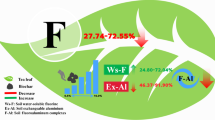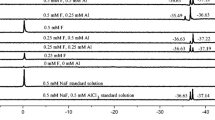Abstract
Drinking teas containing high fluoride (F) imposes fluorosis risk. The soil F bioavailability is an important factor influencing its uptake and contents in teas. The present work was conducted to investigate F fractions in soil and their bioavailability to tea plants. Tea seedlings were cultivated on 6 typical soils treated with a mixture consisting of dolomite, lime, peat and KCl at variable rates in the pot experiment. Soils and young shoots were collected in pairs from 63 sites of 21 plantations in a field experiment. Soil fluoride was sequentially separated into hot water soluble \([{\text{F}}_{{ ( {\text{h, H}}_{ 2} {\text{O,s)}}}} ]\), exchangeable \({\text{F}}\;[{\text{F}}_{{({\text{MgCl}}_{ 2} , {\text{ s}})}} ]\) (by 1 mol L−1 MgCl2, pH = 7.0), F bound to Mn and Fe hydroxides [F(oxides,s)], and organic matter [F(OM,s)] or extracted independently by water \([{\text{F}}_{{ ( {\text{H}}_{ 2} {\text{O)}}}} ]\) or 0.01 mol L−1 CaCl2 solution \([{\text{F}}_{{(0.01{\text{ M CaCl}}_{ 2} )}} ]\). Averaged \({\text{F}}_{{ ( {\text{h, H}}_{ 2} {\text{O,s)}}}}\), \({\text{F}}_{{ ( {\text{MgCl}}_{ 2} , {\text{ s)}}}}\), F(oxides,s) and F(OM,s) accounted for 51, 14, 5 and 30 % of the total sequential extracts, respectively. There were significant correlations among \({\text{F}}_{{ ( 0. 0 1 {\text{ M CaCl}}_{ 2} )}}\), \({\text{F}}_{{ ( {\text{H}}_{ 2} {\text{O)}}}}\) and F(OM,s). Fluoride contents in leaves correlated with \({\text{F}}_{{ ( {\text{H}}_{ 2} {\text{O)}}}}\) (r = 0.71, p < 0.001), \({\text{F}}_{{ ( 0. 0 1 {\text{ M CaCl}}_{ 2} )}}\) (r = 0.93, p < 0.001) and F(OM,s) (r = 0.69, p < 0.01) but not other fractions in the pot experiment and with \({\text{F}}_{{ ( {\text{H}}_{ 2} {\text{O)}}}}\) (r = 0.43–0.57, p < 0.001) and \({\text{F}}_{{ ( 0. 0 1 {\text{ M CaCl}}_{ 2} )}}\) (r = 0.42–0.79, p < 0.001) in the field experiment. It was concluded that 0.01 M CaCl2 extractable fluoride can be a good indicator of soil F bioavailability to tea plants. The significant correlations among some of the F fractions suggested that F in solution, AlF complexes (AlF2 +, AlF2+) and those bound to organic matter likely represent the available pools to tea plants.
Similar content being viewed by others
References
An, J., Lee, H. A., Lee, J., & Yoon, H.-O. (2015). Fluorine distribution in soil in the vicinity of an accidental spillage of hydrofluoric acid in Korea. Chemosphere, 119, 577–582. doi:10.1016/j.chemosphere.2014.07.043.
Arnesen, A. K. M. (1997). Availability of fluoride to plants grown in contaminated soils. Plant and Soil, 191(1), 13–25.
Arnesen, A. K. M., Abrahamsen, G., Sandvik, G., & Krogstad, T. (1995). Aluminium-smelters and fluoride pollution of soil and soil solution in Norway. Science of the Total Environment, 163(1), 39–53. doi:10.1016/0048-9697(95)04479-k.
Balcerzak, M., & Janiszewska, J. (2013). Fluorides in tea products and analytical problems with their determination. Critical Reviews in Analytical Chemistry, 43(3), 138–147. doi:10.1080/10408347.2013.766077.
Braen, S. N., & Weinstein, L. H. (1985). Uptake of fluoride and aluminum by plants grown in contaminationed soils. Water, Air, and Soil Pollution, 24(2), 215–223.
Chan, L., Mehra, A., Saikat, S., & Lynch, P. (2013). Human exposure assessment of fluoride from tea (Camellia sinensis L.): A UK based issue? Food Research International, 51(2), 564–570. doi:10.1016/j.foodres.2013.01.025.
Chen, Z. M., & Lin, Z. (2015). Tea and human health: Biomedical functions of tea active components and current issues. Journal of Zhejiang University-Science B, 16(2), 87–102. doi:10.1631/jzus.B1500001.
Chinese Soil Taxonomy Research Group of Institute of Soil Science of Chinese Academy of Sciences, & Cooperative Research Group on Chinese Soil Taxonomy. (2001). Keys to Chinese soil taxonomy (3rd ed.). Hefei: Press of University of Science and Technology of China. (in Chinese).
Cronin, S. J., Manoharan, V., Hedley, M. J., & Loganathan, P. (2000). Fluoride: A review of its fate, bioavailability, and risks of fluorosis in grazed-pasture systems in New Zealand. New Zealand Journal of Agricultural Research, 43(3), 295–321.
D’Alessandro, W., Bellomo, S., & Parello, F. (2008). Fluorine speciation in topsoils of three active volcanoes of Sicily (Italy). Environmental Geology, 56, 413–423. doi:10.1007/s00254-007-1179-7.
Frankenberger, W. T., Tabatabai, M. A., Adriano, D. C., & Doner, H. E. (1996). Bromine, chlorine, and fluorine. In D. L. Sparks (Ed.), Methods of soil analysis: Part 3. Chemical methods (pp. 833–867). Madison: Soil Science Society of America.
Fung, K. F., Zhang, Z. Q., Wong, J. W. C., & Wong, M. H. (1999). Fluoride contents in tea and soil from tea plantations and the release of fluoride into tea liquor during infusion. Environmental Pollution, 104(2), 197–205.
Gago, C. R., Alvarez, E. R., & Fernandez, M. M. L. (2001). Comparison of methods for fluoride extraction from forest and cropped soils in vicinity of an aluminum smelter in Galicia (NW Spain). Communications in Soil Science and Plant Analysis, 32(15), 2503–2517.
Gago, C., Romar, A., Fernandez-Marcos, M. L., & Alvarez, E. (2014). Fluoride sorption and desorption on soils located in the surroundings of an aluminium smelter in Galicia (NW Spain). Environmental Earth Sciences, 72(10), 4105–4114. doi:10.1007/s12665-014-3304-8.
Gao, H. J., Zhang, Z. Z., & Wan, X. C. (2012). Influences of charcoal and bamboo charcoal amendment on soil-fluoride fractions and bioaccumulation of fluoride in tea plants. Environmental Geochemistry and Health, 34(5), 551–562. doi:10.1007/s10653-012-9459-x.
Kao, C., & Pan, K. (1957). On the characteristic features of the fluorite deposit, Wuyi, Chekiang. Acta Geologica Sinica, 37, 99–108. (in Chinese with English abstract).
Loganathan, P., Gray, C. W., Hedley, M. J., & Roberts, A. H. C. (2006). Total and soluble fluorine concentrations in relation to properties of soils in New Zealand. European Journal of Soil Science, 57(3), 411–421. doi:10.1111/j.1365-2389.2005.00751.x.
Loganathan, P., Hedley, M. J., Wallace, G. C., & Roberts, A. H. C. (2001). Fluoride accumulation in pasture forages and soils following long-term applications of phosphorus fertilisers. Environmental Pollution, 115(2), 275–282.
Loganathan, P., Liu, Q., Hedley, M. J., & Gray, C. W. (2007). Chemical fractionation of fluorine in soils with a long-term phosphate fertiliser history. Australian Journal of Soil Research, 45(5), 390–396. doi:10.1071/sr07030.
Ma, L. F., Shi, Y. Z., Ruan, J. Y., & Han, W. Y. (2001). Status of fluoride of soils from tea gardens in brick tea areas of Hunan, Hubei provinces and its affecting factors. Journal of Tea Science, 22, 34–38. (in Chinese with English abstract).
Pansu, M., & Gautheyrou, J. (2006). Handbook of soil analysis: Mineralogical, organic and inorganic methods. Berlin: Springer.
Ruan, J. Y., Ma, L. F., Shi, Y. Z., & Han, W. Y. (2003). Uptake of fluoride by tea plant (Camellia sinensis L) and the impact of aluminium. Journal of the Science of Food and Agriculture, 83(13), 1342–1348. doi:10.1002/jsfa.1546.
Ruan, J. Y., & Wong, M. H. (2001). Accumulation of fluoride and aluminium related to different varieties of tea plant. Environmental Geochemistry and Health, 23(1), 53–63. doi:10.1023/a:1011082608631.
Shu, W. S., Zhang, Z. Q., Lan, C. Y., & Wong, M. H. (2003). Fluoride and aluminium concentrations of tea plants and tea products from Sichuan Province, PR China. Chemosphere, 52(9), 1475–1482. doi:10.1016/S0045-6535(03)00485-5.
Takmaz-Nisancioglu, S., & Davison, A. W. (1988). Effects of aluminium on fluoride uptake by plants. New Phytologist, 109(2), 149–155.
Tessier, A., Campbell, P. G. C., & Bisson, M. (1979). Sequential extraction procedure for the speciation of particulate trace metals. Analytical Chemistry, 51(7), 844–851. doi:http://pubs.acs.org/doi/pdf/10.1021/ac50043a017.
Weinstein, L. H., & Davison, A. W. (2004). Fluorides in the environment: Effects on plants and animals. Cambridge: CABI International.
Wenzel, W. W., & Blum, W. E. H. (1992). Fluorine speciation and mobility in F-contaminated soils. Soil Science, 153(5), 357–364.
WHO. (2004). Fluoride in drinking water: Background document for development of WHO guidelines for drinking water. WHO/SDE/WSHWHO/03.04/96. Copenhagen, Denmark: World Health Organization.
Wong, M. H., Fung, K. F., & Carr, H. P. (2003). Aluminium and fluoride contents of tea, with emphasis on brick tea and their health implications. Toxicology Letter, 137(1–2), 111–120. doi:10.1016/S0378-4274(02)00385-5.
Xie, Z. M., Ye, Z. H., & Wong, M. H. (2001). Distribution characteristics of fluoride and aluminum in soil profiles of an abandoned tea plantation and their uptake by six woody species. Environment International, 26(5–6), 341–346. doi:10.1016/S0160-4120(01)00010-1.
Zhang, L., Li, Q., Ma, L. F., & Ruan, J. Y. (2013). Characterization of fluoride uptake by roots of tea plants (Camellia sinensis (L.) O. Kuntze). Plant and Soil, 366(1–2), 659–669. doi:10.1007/s11104-012-1466-2.
Zhou, Q., & Sun, T. (2002). Effects of chromium(VI) on extractability and plant uptake of fluorine in agricultural soils of Zhejiang province, China. Water Air and Soil Pollution, 133(1), 145–160. doi:10.1023/a:1012948131082.
Acknowledgments
The study was financially supported by the Ministry of Agriculture of China through the Earmarked Fund for China Agriculture Research System (Project No. CARS 23) and the Agricultural Science and Technology Innovation Program of the Chinese Academy of Agricultural Sciences.
Author information
Authors and Affiliations
Corresponding author
Electronic supplementary material
Below is the link to the electronic supplementary material.
Rights and permissions
About this article
Cite this article
Yi, X., Qiao, S., Ma, L. et al. Soil fluoride fractions and their bioavailability to tea plants (Camellia sinensis L.). Environ Geochem Health 39, 1005–1016 (2017). https://doi.org/10.1007/s10653-016-9868-3
Received:
Accepted:
Published:
Issue Date:
DOI: https://doi.org/10.1007/s10653-016-9868-3




